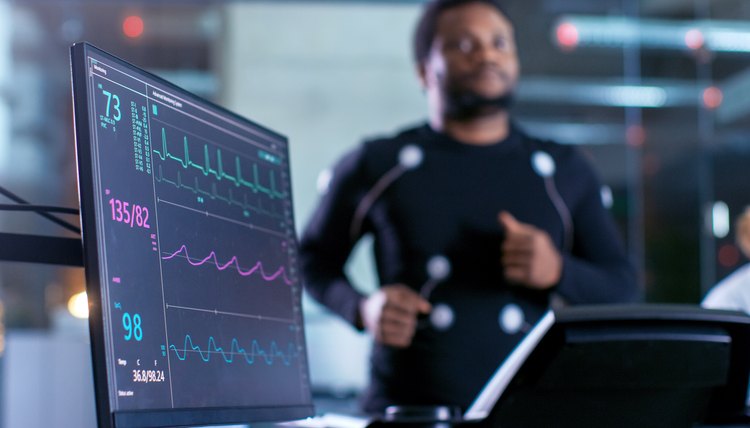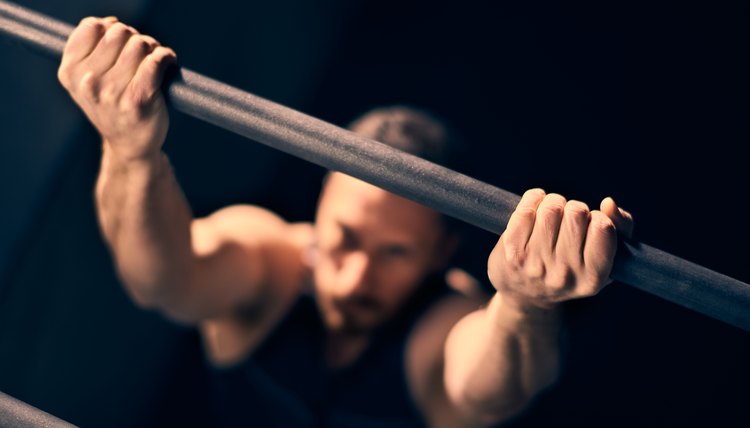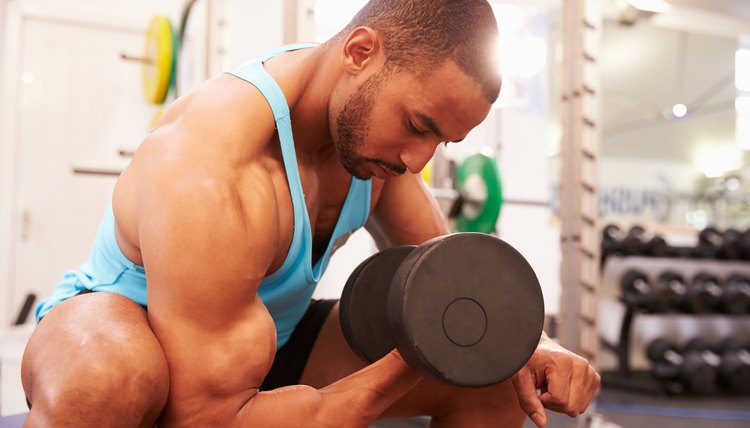A Back & Bicep Split Workout

Pairing your back and biceps muscle workouts is a common way of splitting up an upper body bodybuilding routine as these are the major muscles of the upper body. When you perform back movements such as rows or pull-downs, you're targeting your mid and upper back but also working your biceps, meaning these two muscle groups fit well into the same training split. Your exercise selection, order and sets and reps are of critical importance, though, so it's vital you plan your training program carefully.
When should you do a back-biceps split?
When following a strength training split, with back and biceps brachii being one workout in your schedule, the other workouts could be a chest and triceps session, a quads and hamstrings session, and a shoulders, calves and abs workout. Train your back and biceps once a week. You can do this any day of the week, the only caveat being that if you include deadlifts in your back and biceps workout, you shouldn't do these the day after squats, according to strength coach Jim Smith. Therefore you'll either need to place your leg and back workouts at opposite ends of the week, or leave a day's rest between the two.
Warming up

Jerod Harris/Getty Images Entertainment/Getty Images
Be sure to warm up before getting into your upper body workout. Try some cardio or light back and upper arm movements to prevent injury and help to ramp up your heart rate and blood flow. This will get your rear delts, rhomboids, latissimus dorsi and brachialis ready for hypertrophy.
Begin Big
Start every workout with a big compound move for your back. Deadlifts are one of the best back movements for your first exercise because they work many different muscles in various areas of your back. Along with regular deadlifts with a shoulder width stance, David Dellanave, coach and owner of The Movement Minneapolis, advises trying rack pulls, deficit deadlifts and trap bar deadlifts. Make this a strength-based exercise by deadlifting for five to six sets with a rep range of three to eight repetitions.
Upper-Back Attack

Jerod Harris/Getty Images Entertainment/Getty Images
While deadlifts are a good back exercise, they're mainly lower and mid-back focused, so now it's time to hit your upper back. Your back muscles perform two different movements -- vertical pulls and horizontal pulls, so you need one of each pulling exercise in every session. For the vertical pull, opt for pullups, chinups with any grip position or lat pull-downs using any type of handle. Whatever exercise you choose, touch your chest to the bar and think about pulling your shoulder blades back and down as far as possible, advises strength coach Mike Robertson. For your horizontal pull, any type of rowing range of motion is probably the best exercise you can do. Throw in some barbell rows, dumbbell row, seated cable row or bent-over row to build muscle all across the back during your workout routine. Perform four sets of eight to 12 reps on each exercise.
Biceps Blitz

Jerod Harris/Getty Images Entertainment/Getty Images
By the time you've deadlifted and performed one vertical and one horizontal pull, your biceps will be well worked, but to really get muscle growth going, add in an isolation biceps exercise. The main role of your biceps is to flex your elbow joint, so any strict elbow flexion movement can be used as a biceps finisher.
Strength coaches David Sandler and Jim Stoppani of Muscle and Fitness recommend switching between bicep curls like the hammer curls, cable curls, preacher curls, overhand barbell curls and seated dumbbell curls during your biceps workout routine. Complete two to three sets of 10 to 15 reps, squeezing each one for two seconds and the top and taking three seconds to lower back down. This arm workout should work both the long head of the bicep and the short head. Be sure to work your biceps together and evenly to prevent injury during bicep day. Finish with some bodyweight stretches
References
Writer Bio
Mike Samuels started writing for his own fitness website and local publications in 2008. He graduated from Peter Symonds College in the UK with A Levels in law, business and sports science, and is a fully qualified personal trainer, sports massage therapist and corrective exercise specialist with accreditations from Premier Global International.
